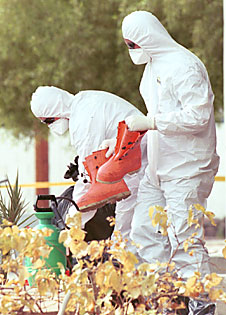 |
|
DAVID HARDEN/Arizona Daily Wildcat
|
Tucson fire fighters clean up after searching the Islamic Center of Tucson for anthrax last year.
|
|
By Rachel Williamson
Arizona Daily Wildcat
Monday September 9, 2002
Cancerous tissues could be identified more quickly during surgery, and anthrax or other types of pollutants in drinking water and soil could be detected more easily with scientists' use of infrared light and the right kind of fiber optics.
Pierre Lucas, UA assistant professor of material science and engineering, has been testing the capabilities of a machine ¸ the FT-IR spectrometer, or Fourier Transform Infrared spectrometer ¸ to identify contaminants and more.
Pollutants, cancer cells and even bacteria each have their own "FT-IR signature," or unique spectrum. The spectrum identifies the contaminant.
The infrared light from the spectrometer can pass through a glass fiber to the sample being tested. In order to identify contaminants, the recipe requires a specific fiber called chalcogenide glass ¸ one of the only fibers that is stable in any environment and transparent to infrared light.
The molecules being tested absorb a certain amount of infrared light, depending upon which material is under the light. Whatever light is not absorbed returns to the spectrometer through a second piece of fiber.
The amount of infrared light that the molecules do not absorb determines the spectrum, or FT-IR signature. Scientists may be able to use the FT-IR signature to identify a contaminant or the presence of cancer cells.
Bacterial spores are more difficult to probe, Lucas said, but testing for spores like anthrax is something he is still looking into.
Benjamin Herman, an atmospheric science professor who specializes in atmospheric radiation, said the difficulty in testing anthrax is its powdery texture and the risk of breathing it in while probing it.
But research shows a lot of potential for testing cancer cells in tissue with the FT-IR spectrometer, Lucas said.
Normally, Lucas said, a sample is brought to the instrument to be tested. However, a smaller version of the spectrometer and cord-like fibers that can be several meters long make the machine transportable.
"Instead of bringing the sample to the machine, we bring the machine to the sample," Lucas said.
While removing localized cancer tissues, surgeons using the FT-IR spectrometer could remove tissues with more precision, without cutting out too much or leaving cancer in the body.
"You can test as you go along in almost real time," Lucas said. "It's minutes versus hours."
The machine can also test soil and underground water in polluted sites for contaminants like jet-engine fuel.

